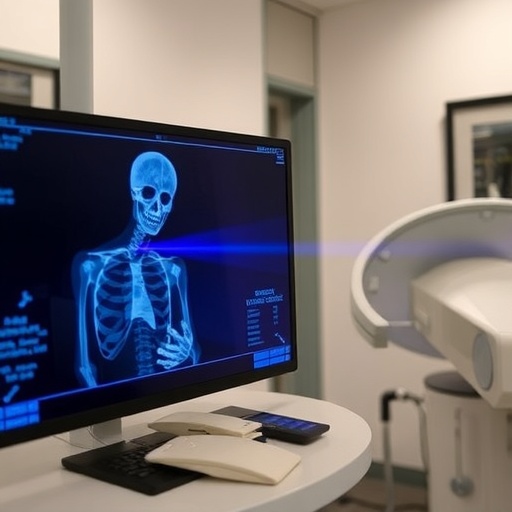
In the ongoing battle against cancer, one of the most significant obstacles has been the challenge of delivering effective chemotherapy that can differentiate between malignant and healthy cells. Conventional chemotherapy agents, while potent against tumor cells, often inflict severe collateral damage on healthy tissues, leading to debilitating side effects and sometimes limiting the doses patients can safely receive. This predicament has motivated scientists to explore alternative strategies that can localize therapy and thereby minimize systemic toxicity. Among these, prodrugs—pharmacologically inert precursors that convert into active drugs in situ—have attracted considerable attention. However, traditional prodrug activation schemes, predominantly relying on the tumor microenvironment’s biochemical cues such as acidity or specific enzymes, have proven inconsistent and frequently fail to achieve precise and robust activation.
Recent years have witnessed attempts to harness external stimuli like light and heat to trigger prodrug activation with greater spatial control. Photodynamic therapy and hyperthermia, for example, aim to confine drug activation to the tumor site by applying external light sources or localized heat. Despite their innovative promise, these modalities suffer from intrinsic limitations including shallow penetration depths and potential harm to surrounding tissues, especially when addressing deeply embedded tumors. This has led researchers to seek alternative external triggers capable of non-invasive, deep tissue penetration with precise energy delivery.
Ultrasound technology, widely employed in medical imaging due to its safety and ability to penetrate soft tissues, has emerged as a compelling candidate for externally controlled drug activation. Ultrasound waves can be focused with high spatial resolution, reaching targets several centimeters beneath the skin without incisions or ionizing radiation. While ultrasound has been traditionally used to physically disrupt tumor cells or enhance permeability for drug delivery, its chemical activation potential remains largely untapped. Turning ultrasound’s mechanical energy into a chemical trigger for prodrug activation would mark a transformative advance in oncological therapy but has been hindered by significant scientific challenges.
.adsslot_A5hVIMwPHm{ width:728px !important; height:90px !important; }
@media (max-width:1199px) { .adsslot_A5hVIMwPHm{ width:468px !important; height:60px !important; } }
@media (max-width:767px) { .adsslot_A5hVIMwPHm{ width:320px !important; height:50px !important; } }
ADVERTISEMENT
A team of researchers from the Changchun Institute of Applied Chemistry at the Chinese Academy of Sciences has recently pushed the boundaries of this frontier by devising a novel ultrasound-responsive nanoparticle platform. The system integrates a specially designed prodrug, R848-N₃, which remains inert until exposed to an activating stimulus, and a catalyst molecule, riboflavin tetrabutyrate, capable of initiating the chemical conversion under ultrasonic excitation. Together, they form composite nanoparticles tailored to accumulate within the tumor microenvironment, where focused ultrasound can be applied externally.
Under ultrasound irradiation, these nanoparticles undergo a unique chemical reaction that cleaves the prodrug and releases its active form. Unlike conventional methods that rely purely on physical disruption, this approach chemically ‘switches on’ the drug selectively at the tumor site. Crucially, the activation process harnesses endogenous molecules such as nicotinamide adenine dinucleotide (NADH), abundant in cells, to fuel the catalytic reaction. This biological synergy imbues the system with remarkable specificity and efficiency, mitigating off-target activation and systemic toxicity.
Experimental evaluation of this ultrasound-induced prodrug activation platform was conducted in preclinical murine models bearing colon tumors. Mice treated with the nanoparticles followed by targeted ultrasound exhibited a dramatic therapeutic response, with tumor growth suppression rates exceeding 99%. Impressively, two-thirds of the treated mice achieved complete tumor remission without any detectable damage to surrounding healthy tissues. These results underscore the promise of ultrasound-driven chemotherapy activation as a paradigm shift, marrying precise spatial control with potent immunomodulatory effects.
Mechanistically, once the prodrug R848-N₃ is liberated, it acts as an immune stimulant, activating local immune cells to attack the tumor more effectively. This dual action—direct chemical activation and immune system engagement—amplifies the therapeutic impact beyond simple cytotoxicity. Additionally, because the ultrasound can be precisely targeted, it allows for repeated treatment cycles without cumulative toxicity, which is a pivotal advantage over conventional chemotherapeutics.
The system’s reliance on riboflavin tetrabutyrate as a catalyst is significant, as riboflavin derivatives are biocompatible and play well-defined roles in biological redox processes. The catalyst absorbs ultrasound energy and facilitates electron transfer reactions, which, in concert with NADH, result in prodrug cleavage. This realm of sonocatalysis—using ultrasound to drive chemical transformations via catalytic processes—is an emerging field, and this study represents a landmark application in biomedicine.
Dr. Zhaohui Tang, a key investigator in this work, remarked on the broader implications: “This work opens a new frontier in ultrasound-based medicine. It’s not just imaging—sound can now ‘switch on’ therapies exactly where needed.” This statement encapsulates the potential paradigm shift from passive diagnostic ultrasound toward active therapeutic ultrasound modalities that dynamically interact with biochemical systems.
The research team, comprising scientists from the Chinese Academy of Sciences, University of Science and Technology of China, and Jilin University, leverages their collective expertise in polymer science, nanotechnology, and biomedical engineering. Their collaboration enabled the sophisticated design of the nanoparticle carriers that ensure stability, biocompatibility, and optimal tumor targeting. Such interdisciplinary synergy is crucial to translating novel concepts from bench to bedside.
Looking forward, the researchers plan to refine this drug activation strategy and initiate clinical trials in human patients. Challenges remain, including scaling nanoparticle production, ensuring safety in long-term use, and adapting ultrasound protocols for varying tumor types and anatomical locations. However, if successful, the clinical translation would herald a safer, more targeted, and more effective cancer therapy modality, reducing the burdensome side effects and improving patient outcomes.
This ultrasound-activated prodrug approach exemplifies how innovative engineering principles can revolutionize cancer treatment, transforming external physical stimuli into precise chemical signals. As the global burden of cancer continues to rise, such technological breakthroughs offer renewed hope by addressing fundamental limitations of existing therapies, potentially reshaping oncology’s therapeutic landscape.
With continued refinement and validation, ultrasound-triggered sonocatalytic activation of prodrugs may soon become a cornerstone of personalized, minimally invasive cancer treatment, enabling clinicians to ‘sound in’ the therapeutic attack with unprecedented control and efficacy.
Subject of Research: Ultrasound-activated prodrug chemotherapy using nanoparticle sonocatalysis for targeted cancer treatment
Article Title: Ultrasound-Triggered Sonocatalytic Activation of Prodrugs Enables Precision Cancer Immunotherapy
Web References: http://dx.doi.org/10.1093/nsr/nwaf140
References: National Science Review, DOI: 10.1093/nsr/nwaf140
Keywords: Ultrasound therapy, prodrug activation, sonocatalysis, nanoparticle drug delivery, cancer immunotherapy, riboflavin catalyst, NADH, targeted chemotherapy, colon cancer model, non-invasive therapy, biomedical nanotechnology, tumor microenvironment
Tags: advanced cancer treatment strategiesexternal stimuli in cancer therapyinnovative cancer therapy techniqueslocalized drug activation methodslow-intensity ultrasound cancer therapyminimizing chemotherapy side effectsovercoming chemotherapy limitationsprecision medicine in oncologyprodrugs for cancer treatmenttargeted chemotherapy deliverytumor microenvironment challengesultrasound-triggered drug release


